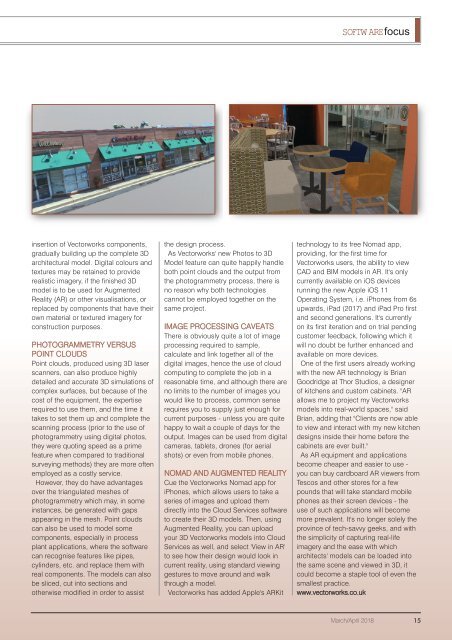CC1803
You also want an ePaper? Increase the reach of your titles
YUMPU automatically turns print PDFs into web optimized ePapers that Google loves.
SOFTWAREfocus<br />
insertion of Vectorworks components,<br />
gradually building up the complete 3D<br />
architectural model. Digital colours and<br />
textures may be retained to provide<br />
realistic imagery, if the finished 3D<br />
model is to be used for Augmented<br />
Reality (AR) or other visualisations, or<br />
replaced by components that have their<br />
own material or textured imagery for<br />
construction purposes.<br />
PHOTOGRAMMETRY VERSUS<br />
POINT CLOUDS<br />
Point clouds, produced using 3D laser<br />
scanners, can also produce highly<br />
detailed and accurate 3D simulations of<br />
complex surfaces, but because of the<br />
cost of the equipment, the expertise<br />
required to use them, and the time it<br />
takes to set them up and complete the<br />
scanning process (prior to the use of<br />
photogrammetry using digital photos,<br />
they were quoting speed as a prime<br />
feature when compared to traditional<br />
surveying methods) they are more often<br />
employed as a costly service.<br />
However, they do have advantages<br />
over the triangulated meshes of<br />
photogrammetry which may, in some<br />
instances, be generated with gaps<br />
appearing in the mesh. Point clouds<br />
can also be used to model some<br />
components, especially in process<br />
plant applications, where the software<br />
can recognise features like pipes,<br />
cylinders, etc. and replace them with<br />
real components. The models can also<br />
be sliced, cut into sections and<br />
otherwise modified in order to assist<br />
the design process.<br />
As Vectorworks' new Photos to 3D<br />
Model feature can quite happily handle<br />
both point clouds and the output from<br />
the photogrammetry process, there is<br />
no reason why both technologies<br />
cannot be employed together on the<br />
same project.<br />
IMAGE PROCESSING CAVEATS<br />
There is obviously quite a lot of image<br />
processing required to sample,<br />
calculate and link together all of the<br />
digital images, hence the use of cloud<br />
computing to complete the job in a<br />
reasonable time, and although there are<br />
no limits to the number of images you<br />
would like to process, common sense<br />
requires you to supply just enough for<br />
current purposes - unless you are quite<br />
happy to wait a couple of days for the<br />
output. Images can be used from digital<br />
cameras, tablets, drones (for aerial<br />
shots) or even from mobile phones.<br />
NOMAD AND AUGMENTED REALITY<br />
Cue the Vectorworks Nomad app for<br />
iPhones, which allows users to take a<br />
series of images and upload them<br />
directly into the Cloud Services software<br />
to create their 3D models. Then, using<br />
Augmented Reality, you can upload<br />
your 3D Vectorworks models into Cloud<br />
Services as well, and select 'View in AR'<br />
to see how their design would look in<br />
current reality, using standard viewing<br />
gestures to move around and walk<br />
through a model.<br />
Vectorworks has added Apple's ARKit<br />
technology to its free Nomad app,<br />
providing, for the first time for<br />
Vectorworks users, the ability to view<br />
CAD and BIM models in AR. It's only<br />
currently available on iOS devices<br />
running the new Apple iOS 11<br />
Operating System, i.e. iPhones from 6s<br />
upwards, iPad (2017) and iPad Pro first<br />
and second generations. It's currently<br />
on its first iteration and on trial pending<br />
customer feedback, following which it<br />
will no doubt be further enhanced and<br />
available on more devices.<br />
One of the first users already working<br />
with the new AR technology is Brian<br />
Goodridge at Thor Studios, a designer<br />
of kitchens and custom cabinets. "AR<br />
allows me to project my Vectorworks<br />
models into real-world spaces," said<br />
Brian, adding that "Clients are now able<br />
to view and interact with my new kitchen<br />
designs inside their home before the<br />
cabinets are ever built."<br />
As AR equipment and applications<br />
become cheaper and easier to use -<br />
you can buy cardboard AR viewers from<br />
Tescos and other stores for a few<br />
pounds that will take standard mobile<br />
phones as their screen devices - the<br />
use of such applications will become<br />
more prevalent. It's no longer solely the<br />
province of tech-savvy geeks, and with<br />
the simplicity of capturing real-life<br />
imagery and the ease with which<br />
architects' models can be loaded into<br />
the same scene and viewed in 3D, it<br />
could become a staple tool of even the<br />
smallest practice.<br />
www.vectorworks.co.uk<br />
March/April 2018 15

















